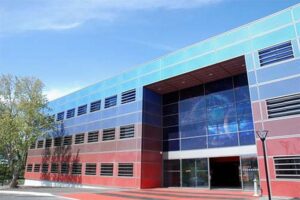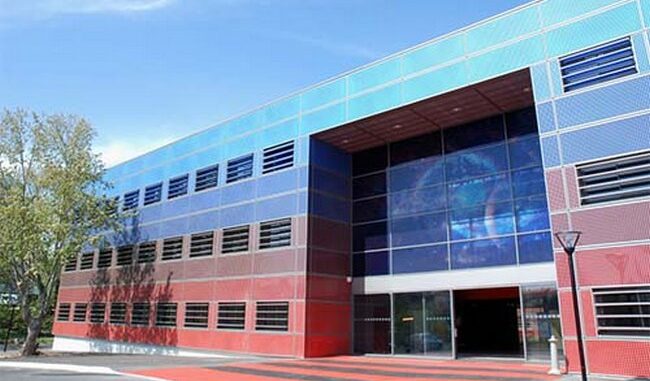 The Laboratoire d’Astrophysique de Marseille (LAM) is a public research laboratory which combines fundamental research in Astrophysics and technological research in instrumentation. The LAM is one of the few laboratories in France where space instruments are designed and built.
The Laboratoire d’Astrophysique de Marseille (LAM) is a public research laboratory which combines fundamental research in Astrophysics and technological research in instrumentation. The LAM is one of the few laboratories in France where space instruments are designed and built.

-
The LAM (Marseille Astrophysics Laboratory)
The LAM is a Joint Research Unit (UMR 7326) from the Centre National de la Recherche Scientifique (CNRS), Aix-Marseille University (AMU) and the National Center for Space Studies (CNES), located on the Technopôle de Château-Gombert since May 2008. Within AMU, LAM is part of the component OSU Institut Pythéas, linking several research units in the fields of earth/environment/space observations, with common services.
The LAM was formed by the merger of the Observatoire de Marseille and the Laboratoire d’Astronomie Spatiale in 2000. It has the experience of several decades of participation in space experiments (SOHO, ISO, Galex, Rosetta, Herschel, COROT, Euclid…), and in major instrumentation programs of ground-based observatories (ESO VLT, ELT, CFHT…).
The laboratory is composed of nearly 200 persons distributed in the scientific teams and the technical services.
-
Research themes
The main research themes are (1) cosmology, galaxy formation and evolution, interstellar medium, (2) planetary systems formation, solar system and (3) optical instrumentation. The research programs are often conducted in the framework of international and international collaborations (ANR, CNES, CNRS, European Community, ESO, ESA, PACA region,…).
The teams conduct large observational campaigns in the field of cosmology, galaxy formation and evolution (COSMOS, Herschel surveys, GALEX, GHASP, VIPERS, VVDS, EUCLID), and in the field of exoplanet studies and solar system exploration (COROT, ROSETTA, SOHO, OHP-SOPHIE, VLT-SPHERE). They lead the analysis and the interpretation of the data by relying on simulations. They prepare the participation of the LAM in the large programs of the future (EUCLID, PLATO, SVOM, E-ELT, ALMA,…), and carry out the necessary R&D to prepare the next generation instrumentation.
-
Ground and Space Instrumentation
The LAM builds instruments on board satellites (SOHO, ISO, Galex, Rosetta, Herschel, Corot,…). It participates in the construction of major instruments for ground-based telescopes (VLT-VIMOS, VLT-SPHERE, PFS-SuMIRE, GTC-EMIR…).
The LAM develops innovative instrumental concepts with an opto-mechanical core in a domain covering the far UV ( 1200A) to the sub-millimeter ( 0.5 mm), with a specialization around wide field multi-object imaging and spectroscopy, and high angular resolution.
The LAM teams are leading instrumental projects for national and international funding agencies (CNES, ESA, NASA, ESO,..).
To know more about the projects involving the LAM, see the Projects page.
-
Technological platforms
The LAM manages two shared technological platforms open to research laboratories and companies, including test facilities in space environment, and the polishing of large optical parts up to 2.5m in diameter. These heavy facilities include assembly, integration and testing facilities in a space environment: vacuum, cryogenics up to 4K, vibrations.
With a set of technical services including skills covering optics, mechanics and electronic control, the LAM is specialized in the system approach of instruments, and the assembly, integration, testing and qualification of large instruments for observatories on the ground or in space.
To learn more about the platforms, see the platform page.
-
CESAM data center
The CESAM (Centre de Données Astrophysiques de Marseille) develops new image processing algorithms, sets up data processing chains, and makes astronomical data available via databases in the framework of the Virtual Observatory. It is an ANO5 labeled center.
To know more about the data made available by CeSAM, see the data page.
-
Training and diffusion of scientific culture
The LAM staff is very involved in training, in particular within the University of Aix-Marseille, and more generally in the dissemination of scientific culture (for example during the ”nuit des chercheurs” or “fête de la science” events, or interventions in classes and other institutions).
See the AGENDA section for the events intended for the general public, and the TRAINING section for the teachings given in astrophysics
-
Stages
Le LAM accueille les étudiants en stage lors de leur parcours après le baccalauréat (voir la page dédiée), et organise des semaines de stage pour les élèves des collèges et lycées, toutes les informations sont disponibles ici.




